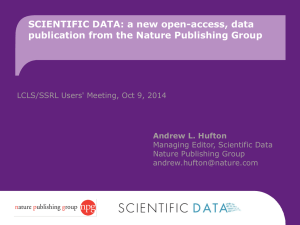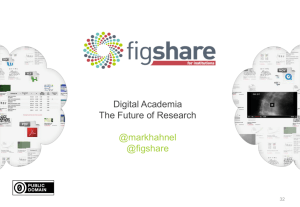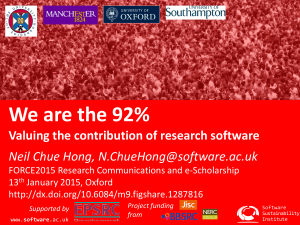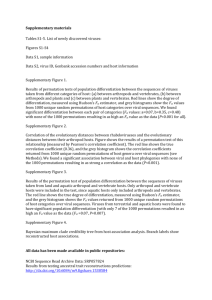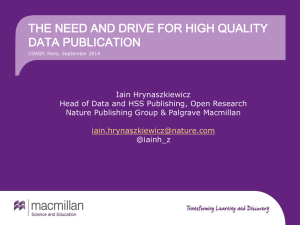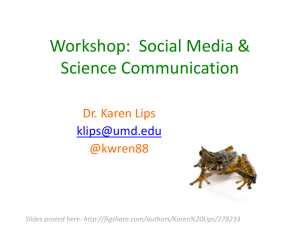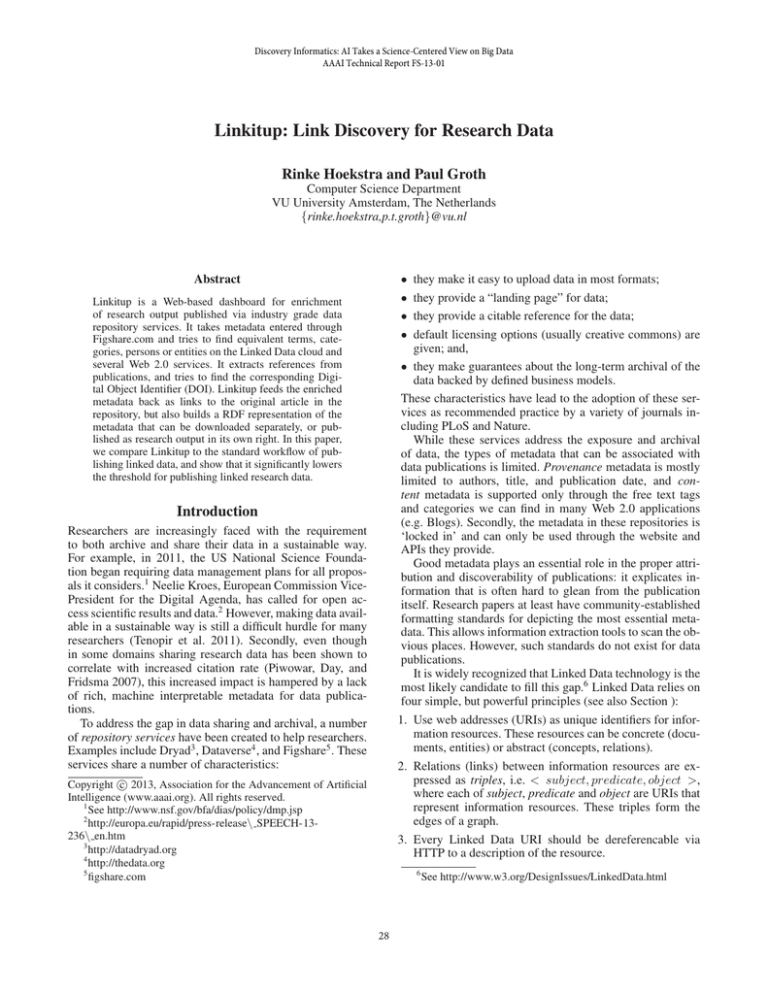
Discovery Informatics: AI Takes a Science-Centered View on Big Data
AAAI Technical Report FS-13-01
Linkitup: Link Discovery for Research Data
Rinke Hoekstra and Paul Groth
Computer Science Department
VU University Amsterdam, The Netherlands
{rinke.hoekstra,p.t.groth}@vu.nl
•
•
•
•
Abstract
they make it easy to upload data in most formats;
they provide a “landing page” for data;
they provide a citable reference for the data;
default licensing options (usually creative commons) are
given; and,
• they make guarantees about the long-term archival of the
data backed by defined business models.
These characteristics have lead to the adoption of these services as recommended practice by a variety of journals including PLoS and Nature.
While these services address the exposure and archival
of data, the types of metadata that can be associated with
data publications is limited. Provenance metadata is mostly
limited to authors, title, and publication date, and content metadata is supported only through the free text tags
and categories we can find in many Web 2.0 applications
(e.g. Blogs). Secondly, the metadata in these repositories is
‘locked in’ and can only be used through the website and
APIs they provide.
Good metadata plays an essential role in the proper attribution and discoverability of publications: it explicates information that is often hard to glean from the publication
itself. Research papers at least have community-established
formatting standards for depicting the most essential metadata. This allows information extraction tools to scan the obvious places. However, such standards do not exist for data
publications.
It is widely recognized that Linked Data technology is the
most likely candidate to fill this gap.6 Linked Data relies on
four simple, but powerful principles (see also Section ):
Linkitup is a Web-based dashboard for enrichment
of research output published via industry grade data
repository services. It takes metadata entered through
Figshare.com and tries to find equivalent terms, categories, persons or entities on the Linked Data cloud and
several Web 2.0 services. It extracts references from
publications, and tries to find the corresponding Digital Object Identifier (DOI). Linkitup feeds the enriched
metadata back as links to the original article in the
repository, but also builds a RDF representation of the
metadata that can be downloaded separately, or published as research output in its own right. In this paper,
we compare Linkitup to the standard workflow of publishing linked data, and show that it significantly lowers
the threshold for publishing linked research data.
Introduction
Researchers are increasingly faced with the requirement
to both archive and share their data in a sustainable way.
For example, in 2011, the US National Science Foundation began requiring data management plans for all proposals it considers.1 Neelie Kroes, European Commission VicePresident for the Digital Agenda, has called for open access scientific results and data.2 However, making data available in a sustainable way is still a difficult hurdle for many
researchers (Tenopir et al. 2011). Secondly, even though
in some domains sharing research data has been shown to
correlate with increased citation rate (Piwowar, Day, and
Fridsma 2007), this increased impact is hampered by a lack
of rich, machine interpretable metadata for data publications.
To address the gap in data sharing and archival, a number
of repository services have been created to help researchers.
Examples include Dryad3 , Dataverse4 , and Figshare5 . These
services share a number of characteristics:
1. Use web addresses (URIs) as unique identifiers for information resources. These resources can be concrete (documents, entities) or abstract (concepts, relations).
2. Relations (links) between information resources are expressed as triples, i.e. < subject, predicate, object >,
where each of subject, predicate and object are URIs that
represent information resources. These triples form the
edges of a graph.
3. Every Linked Data URI should be dereferencable via
HTTP to a description of the resource.
c 2013, Association for the Advancement of Artificial
Copyright Intelligence (www.aaai.org). All rights reserved.
1
See http://www.nsf.gov/bfa/dias/policy/dmp.jsp
2
http://europa.eu/rapid/press-release\ SPEECH-13236\ en.htm
3
http://datadryad.org
4
http://thedata.org
5
figshare.com
6
28
See http://www.w3.org/DesignIssues/LinkedData.html
luv:Article
foaf:Person
rdf:type
rdf:type
lu:figshare_95964
luv:author
lu:figshare_99311
foaf:name
"Stefan Schlobach"
100
Frequency
Figure 1: Example Linked Data graph for an article and its
author.
50
4. Reuse existing identifiers as much as possible.
Figure 1 depicts an example Linked Data graph where
an article (lu:figshare 95964) is associated with its author
(lu:figshare 99311) via a luv:author relation. The URIs
abbreviated with the foaf prefix stem from a frequently used
vocabulary for expressing agents. The URI that identifies the
author can easily be associated with existing author identifiers, such as ORCID, ScopusID or AuthorID.
The web-based architecture of Linked Data, combined
with the reuse of identifiers across descriptions, allows it to
form a semantic network that can span across any number
of data repositories. Any reuse of an identifier between the
description of two datasets forms a bridge that automatically
links the datasets together. The LOD2 statistics maintained
by (Demter et al. 2012)7 indicate that the Linked Data cloud
currently comprises 2289 interlinked open datasets, containing a total of 62 billion relations between resources.
Linked Data has the advantage over standardized content
classification schemes such as e.g. the Universal Decimal
Classification (UDC) that it is much more flexible and dynamic.8 One is free to adopt an existing scheme, such as the
Linked Data version of the UDC9 for describing the content
of a dataset, or one can design a new one, or use both at
the same time. This feature allows Linked Data-based metadata to be much more fine grained. Compare the UDC subject for ‘Anatomy’ (UDC code 611),10 which does not have
any child nodes, with the corresponding category in DBPedia – the most popular Linked Data resource available today
– which has 23 subcategories.11
Unfortunately, existing data repositories do not cater for
the generation of Linked Data. And exposing data as Linked
Data is even more difficult for individual researchers. The
threshold for reaping the potential benefits of Linked Databased metadata for data publications is currently too high.
At the same time, the reliability of services that allow
querying and retrieval of Linked Data is still far from that
0
Connection reset
HTTP
No URL
Not RDF
Other
Unknown response
XML
Type
Figure 2: Distribution of error types identified by LODStats.
provided by the data archiving services mentioned before.
Our analysis12 of the LOD2 statistics shows that for the 299
out of 639 Linked Data datasets that have errors, more than
half of the errors (157) occur because the server hosting the
data cannot deal with the request. For a further 30 cases, the
catalogued dataset is no longer available at the listed URL
(See Figure 2). This means that roughly half the Linked Data
cloud is not accessible.
In short, Linked Data publication is too complicated and
too unreliable. We address these problems through Linkitup,
a web-based dashboard that leverages existing repository
services (currently Figshare.com) to facilitate the publication of Linked Data. Linkitup helps users find and create
links from their data to a variety of existing resources and
exposes those links as Linked Data with associated provenance information. We publish the Linked Data produced
through Linkitup as a separate data publication within the
archive.
Structure of this Paper
In this paper, we present the design and implementation
of Linkitup and discuss how leveraging repository services
changes the Linked Data publication process through technology hiding. We evaluate this process against the current
state of art in Linked Data publication as defined in the
Linked Data Handbook(Heath and Bizer 2011). We demonstrate its benefits in terms of the ease of meeting Linked Data
publication requirements.
The rest of this paper is organized as follows. We begin
by reviewing related work in data management and linked
data for science. We then describe, in Section , the architecture and implementation of Linkitup. This is followed by
the evaluation of the use of Linkitup for linked research data
publication. Finally, we conclude with a discussion of future
directions for this work.
7
These statistics for http://datahub.io are published at http://
stats.lod2.eu
8
The UDC is used by librarians and publishers across the globe
as a classification scheme for subject description and indexing of
the content of information resources. It is maintained by the UDC
Consortium, and is used in over 130 countries for 150-200k document collections, see http://www.udcc.org/index.php/site/page?
view=factsheet.
9
http://udcdata.info/
10
See
http://www.udcc.org/udcsummary/php/index.php?id=
37275&lang=en
11
See http://dbpedia.org/page/Category:Anatomy
12
29
Available at http://dx.doi.org/10.6084/m9.figshare.695949
Related Work
Article List
Data management, archival and sharing has become an increasingly important topic as data sets have grown and many
sciences have become more computational in nature (Akil,
Martone, and Van Essen 2011). Given its importance, the
literature on this topic is large and diverse. Here, our goal
is to call attention to examples in the space and the issues
that they address. We particularly focus on systems that use
Linked Data for science. We begin with a discussion of data
archiving in science.
Plugins
Article Details
Actions
Data Archival in Science A particular important motivation for scientific data archival and sharing has been the
requirement for reproducibility in science (Mesirov 2010).
Freire et al. highlight the challenges for reproducibility in
computational systems (Freire, Bonnet, and Shasha 2012).
Systems such as Share (Gorp and Mazanek 2011), iPython
(Pérez and Granger 2007) and many workflow systems
(Deelman et al. 2009) provide mechanisms for reproducing computational science based on shared data (Goble et
al. 2008).
To facilitate data sharing and archival, many data repositories have been created.13 Beyond the repositories discussed in the introduction, there is a long history of domain specific data repositories as well as nationally sponsored data repository. For example, in social science, there
is the Inter-university Consortium for Political and Social
Research14 . In linguistics, there is the Linguistic Data Consortium15 . In biomedicine, there are databases such as the
Protein Data Bank16 or the Reference Sequence Database17 .
There are also national scientific data repositories for example the Australian National Data Management Service18 and
the Dutch DANS EASY archive19 . A key aspect of these
data repositories is that they aim to provide long term hosting and curation of data (Marcial and Hemminger 2010).
Figure 3: The Linkitup dashboard interface
pointed out how Linked Data can be leveraged to improve
science. Kauppinen et al. describe Linked Science – the
use of Linked Data for interconnecting scientific data to
enable new science to be done (Kauppinen, Baglatzi, and
Keßler forthcoming 2012). The need for Linked Data is bolstered by Wynholds who calls for an infrastructure for scientific data set linking (Wynholds 2011). Linked Data can
also enable the connection between data and scientific models (Mäs et al. 2011). Finally, a number of authors have
introduced approaches for encapsulating data sets for attribution and credit using Linked Data (Mons et al. 2011;
Bechhofer et al. 2013).
The closest work with respect to ours is the work from Gil
et al. on Organic Data Publishing (Gil, Ratnakar, and Hanson 2012). Like our proposal, this work calls for the use of
web environments and semantic standards to ease the scientific data sharing process. A key difference is that our work
leverages existing repository services, not semantic wikis,
and is focused primarily on link creation rather than data curation. We now discuss the architecture and implementation
of Linkitup.
Linked Data for Science Data preparation forms the bulk
of work done in scientific workflows (Garijo et al. 2012).
Metadata and semantics is seen as key for leveraging scientific data (Gray et al. 2005). A number of disciplines use Semantic Web and Linked Data for sharing data. For example,
in neuroscience data is exposed as Linked Data via the Neuroscience Information Framework.20 The biomedical community shares its terminologies using Semantic Web standards through BioPortal(Whetzel et al. 2011). The systems
biology community shares their data using similar standards
(Wolstencroft et al. 2011). Nature also exposes their article
metadata as Linked Data.21 .
Beyond the usage of Linked Data standards for exposing data in various communities, a number of authors have
Architecture & Implementation
13
Linkitup is a Web-based dashboard for interacting with a
Figshare “article” and the metadata that is already associated with it. A Figshare “article” can be anything from figures, datasets, media files, papers and posters to sets of files.
Article metadata typically consists of the title, all authors,
a description, one or more categories (field of research) to
which the article belongs, several tags and any number of
(hyper)links to relevant external resources, such as an author’s homepage, project website, etc. An author can mark
See http://databib.org for a comprehensive listing.
14
http://www.icpsr.umich.edu/
15
http://www.ldc.upenn.edu
16
http://www.rcsb.org/pdb/home/home.do
17
http://www.ncbi.nlm.nih.gov/refseq/
18
http://www.ands.org.au/index.html
19
http://www.dans.knaw.nl/en
20
http://www.neuinfo.org/
21
http://data.nature.com
30
Figure 6: Suggested links to the NIF Registry
Figure 4: Suggested links to Wikipedia (DBPedia, actually).
are accessible on the left (“Plugins”). As mentioned in the
introduction, the Figshare metadata is internal to that service. Linking services essentially tie Figshare specific identifiers to Linked Data URIs. A verbatim Linked Data version
of the Figshare metadata may use the right format, but does
not reuse existing URIs, and therefore does not link to any
other datasets or descriptions thereof. The linking services
are separate modules that implement the interaction between
an article’s metadata, and third party services.
A plugin typically uses a selection of article metadata
(tags, categories, authors) to query a remote service, and returns a list of candidate matches. The results are rendered
to a dialog using a standard UI template. This allows users
to select links they deem correct using an interface that is
independent of the plugin used.
Crucial in this process is that the user is in control of
which links are added to the dataset. Figure 4 shows candidate links from our paper to DBPedia; selected links lit up
in green. DBPedia is a Linked Data version of the so-called
info boxes on Wikipedia and works as a switchboard for the
web of data: URIs coming from DBPedia are reused across
virtually all Linked Data sets currently available. The DBPedia plugin retrieves the URIs of resources from DBPedia
for which the label matches that of any tag or category associated with the article through Figshare.
At the time of writing, Linkitup is equipped with nine plugins that serve to demonstrate the range of services we can
connect to. Four plugins call a REST service, three use a
SPARQL endpoint, one uses a custom scraper and one is
based on the content of the Figshare article (Table 1):
Figure 5: Suggested links from authors to DBLP
an article as private or public. Once an article is made public, it is assigned a DOI, and an official citation text.
To get to the dashboard, a user has to login and allow
Linkitup access to its articles on Figshare.com. Users can
quickly find and select an article to enrich through the article list (top left in Figure 3). All article details are retrieved
directly through the Figshare.com API.22 Linkitup currently
does not support publication and enrichment services independently from Figshare, but the two platforms work together seamlessly.
Linkitup Plugins
REST-Based Plugins The Elsevier Linked Data Repository (LDR)23 is a “set of services and APIs [. . . ] to store and
retrieve content enhancements and other forms of semantic
metadata about both Elsevier content and content available
in other resources published on the Web”. Although cur-
Figure 3 shows a screenshot of the Linkitup dashboard for a
paper about a prototype system for clinical decision support
(Hoekstra et al. 2012). The standard Figshare metadata is
shown on the right (“Article Details”), and linking services
22
23
See http://api.figshare.com.
31
See http://data.elsevier.com
Name
Elsevier LDR
ORCID
NIF Registry
LinkedLifeData
DBPedia
DBLP
NeuroLex
DANS EASY
Crossref
Service
REST
REST
REST
REST
SPARQL
SPARQL
SPARQL
Custom
Custom
Source
Tags & Categories
Authors
Tags & Categories
Tags & Categories
Tags & Categories
Authors
Tags & Categories
Tags & Categories
Citations
Links to
Funding agencies
ORCID Author IDs
Datasets
Entities & Concepts
Entities & Concepts
Authors
Concepts
Datasets
DOIs
Table 1: Overview of Linkitup plugins
of LLD to retrieve matching resources.28
SPARQL-Based Plugins SPARQL is, analogous to SQL
in database land, the standard query language and protocol
for Linked Data.29 The DBPedia plugin uses the DBPedia
SPARQL endpoint to lookup resources with a label corresponding to one of the tags and categories of the current
Figshare.com article. A Linkitup user will be presented the
more familiar “Wikipedia” results.
The DBLP plugin relates author names to authors of publications in the DBLP Computer Science Bibliography30
through the SPARQL endpoint hosted by the L3S Research
Center31 Figure 5 shows the DBLP identifiers that match the
author names for our paper.
NeuroLex is a Wiki-based lexicon of important terms in
neuroscience.32 Like the NIF registry, it is part of the Neuroscience Information Framework, and it is constructed to
“help improve the way that neuroscientists communicate
about their data”. The NeuroLex plugin uses a SPARQL
endpoint to retrieve resources that have a label that corresponds with one of the tags or categories associated with the
Figshare article.
Figure 7: Extracted references presented by the CrossRef
plugin
rently the LDR exposes only a single vocabulary (the SciValFunders vocabulary)24 it hosts many more, and it is expected
that the number of publicly accessible information resources
will grow. The LDR plugin matches tags and categories to
concepts in the LDR via the LDR REST interface.
The ORCID plugin allows users to unambiguously identify the authors of their article by relating the Figshare author identifier to an ORCID.25 ORCID is an open platform
for issuing persistent digital identifiers for researchers, and
allows for automatic linking to other author identifiers, such
as the Scopus Author ID of Elsevier and the ResearcherID
of Thomson Reuters.
NIF Registry is the data registry of the Neuroscience
Information Framework (Akil, Martone, and Van Essen
2011).26 The NIF registry catalogs “electronic resources that
have been selected by NIF curators, or contributed by the
community, as valuable tools for researchers and students
in the field of neuroscience. [. . . ] It contains datasets, software tools, brain atlases, granting agencies, tissue banks,
and many others”. The plugin uses categories and tags associated with an article to find potentially relevant entries in
the registry. Figure 6 shows an example results list for this
plugin.
LinkedLifeData (LLD) is an integrated repository of major information resources in the health care and life sciences
developed by the LarKC project.27 URIs in LLD are based
on UMLS identifiers, with labels associated from integrated
thesauri, datasets and publications such as MeSH, UniProt
and PubMed. The LLD plugin again uses the tags and categories of an article against the autocomplete REST service
Custom Plugins DANS EASY is the electronic archiving
system for research data of Data Archiving and Network
Services (DANS),33 an institute of the Netherlands Royal
Academy (KNAW) and the Netherlands Research Organisation (NWO). EASY stores a huge number of datasets from
the humanities and social sciences, and is growing in importance with the emphasis on data publication by the major
funding agencies. The DANS EASY plugin uses tags and
categories of a Figshare.com article to find related datasets
in EASY, and returns a title, description and persistent identifier for those datasets. DANS EASY does not offer a search
API and we had to resort to a simple scraping-solution on top
of its HTML-form based search interface.
Finally, the CrossRef plugin stands out from the pack in
that it is not based purely on metadata, but extracts citations
28
The autocomplete service runs directly against a full text index of the LLD corpus, making it perform significantly faster than
using the LLD SPARQL endpoint.
29
See http://www.w3.org/TR/sparql11-overview/
30
See http://dblp.uni-trier.de.
31
See http://www.l3s.de and the endpoint at http://dblp.l3s.de/
d2r/sparql.
32
See http://neurolex.org.
33
See http://dans.knaw.nl.
24
See http://www.funding.scival.com/.
See http://orcid.org
26
See http://www.neuinfo.org/products/nif registry.shtm
27
See http://linkedlifedata.com and http://larck.eu respectively.
25
32
from the Figshare article,34 and returns potential matches in
the CrossRef DOI registry by calling its REST service (see
Figure 7). This allows authors to provide explicit links between their Figshare article and the DOIs of cited papers.
Decide on
Resources to
describe
Publishing Linkitup Linked Data
Decide on
Mint URIs
Triples to
Include
Describe
Choose
Define
Make
the Dataset
Vocabularies
Terms
Links
Figure 8: Steps in Linked Data publishing, as described in
(Heath and Bizer 2011).
Linkitup publishes the results of the enrichment process in
two ways: 1) the links section of the original article on
Figshare is updated with the newly found links to external
resources, and 2) it generates a Linked Data representation
of all metadata as a nanopublication (Schultes et al. 2012)
that is made available both as separate article on Figshare,
and to a triple store. The two Figshare articles are connected
by key-value tags of the form “RDF=$hnanopub\ idi$” and
“about=$harticle\ idi$”, respectively.
A nanopublication as defined in (Schultes et al. 2012)
consists of three parts: an assertion, containing the contents
of the publication, supporting evidence for the claims in the
assertion, and provenance describing the processes that led
to the publication. Since Linkitup nanopublications are essentially annotations of other publications, rather than independent assertions, we intermix the nanopublication format
with both the standard Linked Data for provenance, PROV
(Groth and Moreau 2013), and a schema for expressing annotations as Linked Data, the Open Annotation (OA) specification.35
All PROV and Open Annotation statements are contained
in the provenance part of the publication. In addition to
the basic assertions shown here, this part contains author
details and a PROV description of the generating activity
(e.g. lu:linkitup 20130501T113510) including timestamps.
The assertion combines a verbatim Linked Data representation of the Figshare article metadata, with the links found
through the Linkitup application. Depending on the plugin, a
link may be represented as a ‘match’ with a Figshare tag or
category, or as a resource that is ‘related’ to the Figshare
article itself. For instance, links found to LinkedLifeData
and DBPedia resources are matches, whereas datasets found
in DANS EASY or the NIF Registry are merely related resources.
to the process of linked data publishing described in the
Linked Data Handbook (Heath and Bizer 2011, Chapter 4).
From (Heath and Bizer 2011), we identify six considerations in the publishing chain: decide how to mint Cool URIs
(section 4.1), decide on triples to include in the description
of a resource (section 4.2), describe the dataset itself (section 4.3), choose appropriate vocabularies (sections 4.4.14.4.6), if necessary define additional terms (section 4.4.6),
and make links to and from external data sources (section
4.3). We briefly discuss each consideration in the context of
Linkitup.
Mint Cool URIs Resource URIs should follow the Linked
Data principles, and be cool.36 In short, they should follow
the HTTP URI scheme, and be dereferencable to a description of the resource they identify. The format of the description depends on the client that uses the URI as URL.
(Heath and Bizer 2011) summarize these rules as: keep out
of namespaces that you do not control, abstract away from
implementation details, and use natural keys within URIs
(section 4.1).
Linkitup naturally meets all of these requirements. First
of all, it uses a standard slash-based URI scheme, that is
used for all resources published by Linkitup. The form of the
< article uri > depends on whether the Figshare article is
private or public. For the former, we use the form:
http://linkitup.data2semantics.org/
resource/figshare [Article ID]
and for the latter we add an equivalence relation (owl:
sameAs) with a standard DOI-based URI. URIs for tags,
categories and authors only use the latter method. Figshare
identifiers are shared across articles between literally equivalent tags. Categories and their identifiers are global by nature.
Evaluation: Compliance with Linked Data
Publishing
Triples to Include (Heath and Bizer 2011) go in some detail to discuss what triples should be returned to a HTTP
request for the description of a resource. For now, Linkitup
Linked Data will be hosted through an adapted Pubby37 interface that returns an HTML description of the resource that
contains both incoming and outgoing links. Another possible
approach is to use the Linked Data API38 to provide REST
web services access to the underlying data as done by the
OpenPHACTS project (Gray et al. 2012).
Linkitup transforms the process of publishing linked research data by hiding the underlying technology. Technology hiding allows researchers to enrich their data without
having to go through the steps typically associated with
linked data publishing (Figure 8).
In this section we evaluate the advantages and inevitable
tradeoffs inherent in this approach by comparing Linkitup
34
Linkitup uses pdfminer, https://github.com/euske/pdfminer/,
together with regular expressions based on standard LateX bibliography styles listed at http://amath.colorado.edu/documentation/
LaTeX/reference/faq/bibstyles.html.
35
The Open Annotation model is defined by the W3C
Open Annotation community group, and is subject to change.
Linkitup uses the community draft of February 2013, http://www.
openannotation.org/spec/core/20130208/index.html.
36
See http://www.w3.org/DesignIssues/LinkedData.html and
http://www.w3.org/TR/cooluris/
37
Pubby is a standard front end for triple stores, that implements
the basics of content negotiation for Linked Data, see http://github.
com/cygri/Pubby.
38
http://code.google.com/p/linked-data-api/
33
Describe the Dataset A dataset can be described in terms
of what it is about, e.g. using the ‘voiD’ vocabulary,39
how it came about, using the PROV vocabulary, and how
it can be used in terms of licensing, waivers and norms.
Figshare publishes figures, media, poster, papers and filesets
under a CC-BY license. Datasets are published under CC0.
Since Linkitup nanopublications are published as dataset on
Figshare, they automatically fall under the CC0 license. The
Linkitup metadata contains an assertion to that effect, using
the Dublin Core license property (dcterms:license). Linkitup
currently does not publish a voiD description of the nanopublication, but it does include provenance information of the
linking process using the PROV vocabulary. Future versions
will incorporate the provenance of individual plugins runs.
and the user.
Conclusion
In this paper, we described Linkitup, a dashboard enabling
the discovery and publication of linked research data by
leveraging an existing repository service, Figshare.com. Importantly, Linkitup provides crucial benefits over existing
Linked Data publication practices in terms of easy of use
(technology hiding) and persistence (i.e. relying on the
archives guarantees). Going forward, are working to expand the integration of Linkitup with other commonly used
services, e.g. by publishing directly from Dropbox into
Figshare via Linkitup, and by supporting other repositories
(e.g. DANS EASY).
We already have a prototype implementation to that effect
that analyzes, extracts and visualizes information from the
data along the way.41 Additionally, we will expand the number of services that Linkitup supports, in particular, through
deeper content analysis. Finally, we aim to provide richer
notifications to let users track how their data is being interlinked. While Linkitup is focused on science, it also serves
as a model for the integration of user facing Web 2.0 services with Linked Data publication, which potentially help
us build a richer Web of Data.
Vocabularies & Terms It is important that Linked Data
publishers express their data as much as possible in terms
of existing vocabularies. As described in (Heath and Bizer
2011), it may be hard to choose the right vocabulary to
use since not all vocabularies are equally stable (maintenance), widespread, broad or expressive. Linkitup uses a
small selection of well known vocabularies for publishing
enriched data (DCTerms, FOAF, SKOS, PROV, OA and
Nanopub). These vocabularies have broad user bases, and
strong community backing. Linkitup also uses its own vocabulary alongside these, to maintain a mapping with the
terminology used in the Figshare API.
Acknowledgments This publication was supported by the
Dutch national program COMMIT.
Make Links This step lies at the heart of what Linkitup
and Linked Data are about. Every Linkitup plugin tries to
put the Figshare article into context by mapping its rudimentary metadata to richer descriptions from (linked) data
sets. These plugins – and thus data sets – represent the external linking targets described in (Heath and Bizer 2011,
Section 4.3): Linkitup takes care of identifying and selecting
appropriate targets for linking research data. We foresee that
a growing number of plugins will make it necessary to categorize them to a specific profile, inspired by the categories
assigned to the Figshare article. A historian is not very likely
to have much interest in linking a publication or dataset to a
Neuroscience lexicon.
Linkitup supports users to manually select automatically identified candidates for linking and expresses these
links with predefined predicates from the SKOS vocabulary
(again (Heath and Bizer 2011, Section 4.3)). This arguably
restricts the freedom of users to create links fully manually,
but gives them more control over the quality of links than
fully automatic link creation.40 Even though most plugins
work on the basis of a literal string match between a Figshare
author name, tag or category and a term hosted by the external service, the results from non-SPARQL based services are
typically returned with some degree of confidence (a score).
Linkitup plays the modest role of broker, and lets the weighting of the quality of results to the original service provider
References
Akil, H.; Martone, M. E.; and Van Essen, D. C. 2011. Challenges and opportunities in mining neuroscience data. Science 331(6018):708–712.
Bechhofer et al., S. 2013. Why linked data is not enough for
scientists. Future Generation Computer Systems 29(2):599
– 611. Special section: Recent advances in e-Science.
Deelman, E.; Gannon, D.; Shields, M.; and Taylor, I. 2009.
Workflows and e-science: An overview of workflow system
features and capabilities. Future Generation Computer Systems 25(5):528–540.
Demter, J.; Auer, S.; Martin, M.; and Lehmann, J. 2012.
Lodstats – an extensible framework for high-performance
dataset analytics. In Proceedings of the EKAW 2012, Lecture
Notes in Computer Science (LNCS) 7603. Springer. 29
Freire, J.; Bonnet, P.; and Shasha, D. 2012. Computational
reproducibility: state-of-the-art, challenges, and database research opportunities. In Proceedings of the 2012 international conference on Management of Data, 593–596. ACM.
Garijo, D.; Alper, P.; Belhajjame, K.; Corcho, O.; Gil, Y.;
and Goble, C. 2012. Common motifs in scientific workflows: An empirical analysis. In 8th IEEE International
Conference on eScience. USA: IEEE Computer Society
Press.
Gil, Y.; Ratnakar, V.; and Hanson, P. C. 2012. Organic data
publishing: A novel approach to scientific data sharing. In
Kauppinen et al. (2011).
39
voiD: vocabulary of interlinked datasets, see http://www.w3.
org/TR/void/.
40
Advanced users can add their own links by editing the resulting nanopublication by hand, and uploading it as a new version to
Figshare.
41
34
See http://data2semantics.github.io/#goldendemo
Goble, C.; Stevens, R.; Hull, D.; Wolstencroft, K.; and
Lopez, R. 2008. Data curation + process curation=data integration + science. Briefings in Bioinformatics 9(6):506–517.
Gorp, P. V., and Mazanek, S. 2011. Share: a web portal for
creating and sharing executable research papers. Procedia
Computer Science 4(0):589 – 597. Proceedings of the International Conference on Computational Science, {ICCS}
2011.
Gray, J.; Liu, D. T.; Nieto-Santisteban, M. A.; Szalay, A. S.;
DeWitt, D. J.; and Heber, G. 2005. Scientific data management in the coming decade. CoRR abs/cs/0502008.
Gray, A. J.; Groth, P.; Loizou, A.; Askjaer, S.; Brenninkmeijer, C.; Burger, K.; Chichester, C.; Evelo, C. T.; Goble, C.;
Harland, L.; et al. 2012. Applying linked data approaches to
pharmacology: Architectural decisions and implementation.
Semantic Web.
Groth, P., and Moreau, L. 2013. PROV-Overview: An
Overview of the PROV Family of Documents. Working group note, W3C. http://www.w3.org/TR/2013/NOTEprov-overview-20130430/. Latest version available at http:
//www.w3.org/TR/prov-overview/.
Heath, T., and Bizer, C. 2011. Linked Data: Evolving the
Web into a Global Data Space. Synthesis Lectures on the
Semantic Web: Theory and Technology. Morgan & Claypool.
Hoekstra, R.; Magliacane, S.; Rietveld, L.; de Vries, G.;
Wibisono, A.; and Schlobach, S. 2012. Hubble: Linked
Data Hub for Clinical Decision Support. In Post conference
demo proceedings of ESWC 2012.
Kauppinen, T.; Baglatzi, A.; and Keßler, C. forthcoming
2012. Linked Science: Interconnecting Scientific Assets. In
Critchlow, T., and Kleese-Van Dam, K., eds., Data Intensive
Science. USA: CRC Press.
Kauppinen, T.; Pouchard, L. C.; and Keßler, C., eds. 2011.
Proceedings of the First International Workshop on Linked
Science 2011, Bonn, Germany, October 24, 2011, volume
783 of CEUR Workshop Proceedings. CEUR-WS.org.
Marcial, L. H., and Hemminger, B. M. 2010. Scientific data
repositories on the web: An initial survey. Journal of the
American Society for Information Science and Technology
61(10):2029–2048.
Mäs, S.; Müller, M.; Henzen, C.; and Bernard, L. 2011.
Linking the outcomes of scientific research: Requirements
from the perspective of geosciences. In Kauppinen et al.
(2011).
Mesirov, J. P. 2010. Accessible reproducible research. Science 327(5964):415–416.
Mons et al., B. 2011. The value of data. Nature Genetics
43(4):281–283.
Pérez, F., and Granger, B. E. 2007. IPython: a System for Interactive Scientific Computing. Comput. Sci. Eng. 9(3):21–
29.
Piwowar, H. A.; Day, R. S.; and Fridsma, D. B. 2007. Sharing detailed research data is associated with increased citation rate. PloS one 2(3):e308.
Schultes, E.; Chistester, C.; Burger, K.; Groth, P.; Kotoulas, S.; Loizou, A.; Tkachenko, V.; Waagmeester, A.;
Askjaer, S.; Pettifer, S.; Harland, L.; Haupt, C.; Batchelor,
C.; Vazquez, M.; Fernandez, J. M.; Saito, J.; Gibson, A.;
and Wich, L. 2012. The Open PHACTS Nanopublication
Guidelines. Technical report.
Tenopir, C.; Allard, S.; Douglass, K.; Aydinoglu, A. U.; Wu,
L.; Read, E.; Manoff, M.; and Frame, M. 2011. Data sharing by scientists: Practices and perceptions. PLoS ONE
6(6):e21101.
Whetzel, P. L.; Noy, N. F.; Shah, N. H.; Alexander, P. R.;
Nyulas, C.; Tudorache, T.; and Musen, M. A. 2011. Bioportal. Nucleic acids research 39(suppl 2):W541–W545.
Wolstencroft, K.; Owen, S.; du Preez, F.; Krebs, O.; Mueller,
W.; Goble, C.; and Snoep, J. L. 2011. The seek: A platform
for sharing data and models in systems biology. In Methods
in Systems Biology, volume 500 of Methods in Enzymology.
Academic Press. 629 – 655.
Wynholds, L. 2011. Linking to scientific data: Identity problems of unruly and poorly bounded digital objects. International Journal of Digital Curation 6:214–225.
35

